Table of Contents[Hide][Show]
A nourishing homemade baby formula using safe, whole ingredients. This recipe was developed and tested by Dr. Mary Enig, a PhD Nutritionist and originally published in Nourishing Traditions cookbook in 1996. It was formulated to match breastmilk as closely as possible and is also suitable for infants. Source: Weston A. Price Foundation
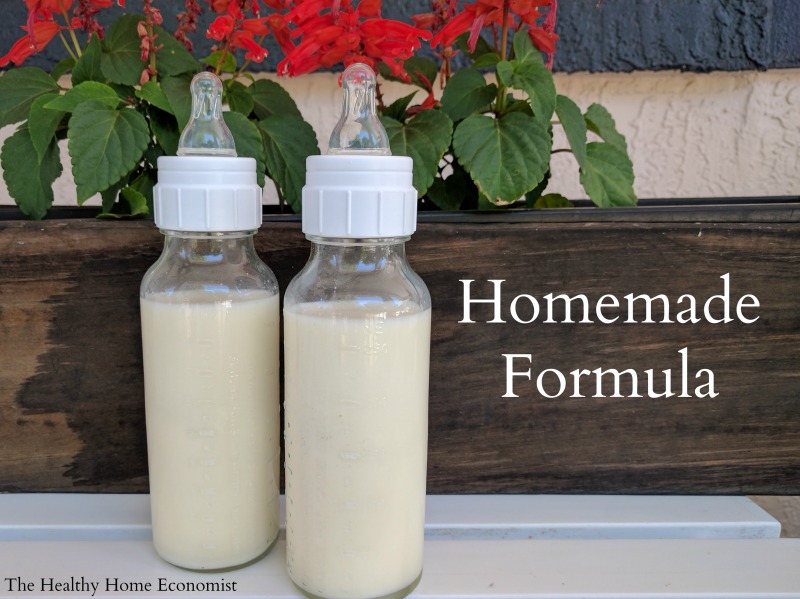
There is no doubt that breastfeeding your baby is the best option for the child’s long-term health and development. Human breastmilk from a well-nourished mother is the perfect food for baby. However, in circumstances where the child is adopted or the Mother finds herself unable to breastfeed, formula feeding becomes necessary. In those cases, homemade baby formula is best.
Using a baby formula recipe that closely matches the nutritional profile of breastmilk is a far better choice than even organic baby formula from the health food store. More on this below.
Note: Donor programs are widely available for human breastmilk. But, the diets of the donor mothers are unknown and most likely nutritionally insufficient. In addition, breastmilk banks pasteurize the donated breastmilk which destroys much of the nutritional benefit. Unless you are fortunate to have a trusted and direct donor milk source in your community, avoid this option!
Dangers of Commercial Formula
Commercial formulas are always a poor choice for a number of reasons. First of all, formula manufacturers line the cans with the chemical BPA. This substance disrupts hormone development and is a probable contributor to early puberty in girls, and ADHD, urogenital abnormalities, and other ills in boys.
The European Food Safety Authority found that canned commercial formula is a significant source of BPA for infants, exposing the child to 13mcg of BPA per kg of body weight per day! BPA-free formula cans are no better. The chemical BPS is typically used instead which is just as dangerous.
Beware that manufacturers pack even organic commercial formula like Earth’s Best in BPA cans. Worse, they use organic brown rice syrup as the primary sweetener which is known to be frequently contaminated with arsenic.
In addition, all commercial milk formulas are processed at extremely high temperatures which violently denature the fragile milk proteins, render them allergenic, and add carcinogens to the final product. Soy infant formula is the worst. Obscenely high processing temperatures not only denature the proteins but large levels of phytic acid in soy block mineral absorption by the infant. Moreover, soy-based plant estrogens disrupt the hormonal development of the baby!
It seems that for the concerned Mother who is unable to breastfeed, learning how to make baby formula at home with safe, pure ingredients is the most prudent way to go!
Why Make Homemade Formula Even if You Are Breastfeeding
In the video below, I show you how to make your own safe, healthy raw milk homemade formula for your baby.
The recipe I follow was originally published in the cookbook Nourishing Traditions in 1996 and developed by Dr. Mary Enig.
Even though I breastfed each of my children for at least 2 years, I made this exact formula for my own children when I was away for the day or the evening as pumping was not an option that worked well for me.
I even used this homemade formula for an entire day once when I had some dental work done and was advised to pump and discard for 24 hours.
As a result, even successfully breastfeeding Moms can use this wonderful homemade formula as a supplement when necessary to their own nutrient-dense breastmilk!
It is advised that even breastfeeding Mothers have the ingredients for this formula on hand for an emergency. If Mom is sick or otherwise unable to nurse, Dad can step in and make this safe alternative until Mom is back on her feet. It takes a few days to a week to gather all the ingredients together to make this formula, which is why I advise having them on hand at all times.
Homemade Most Nutritious
The image below lists the reasons why it is worth it nutritionally to make formula yourself for your precious baby!
You can order all of the required ingredients for the homemade baby formula in one package from this reputable, vetted source.
Moms who have successfully used this formula feeding your children, please post about your experience in the comments section to encourage those who are considering it and need some Mom to Mom encouragement!
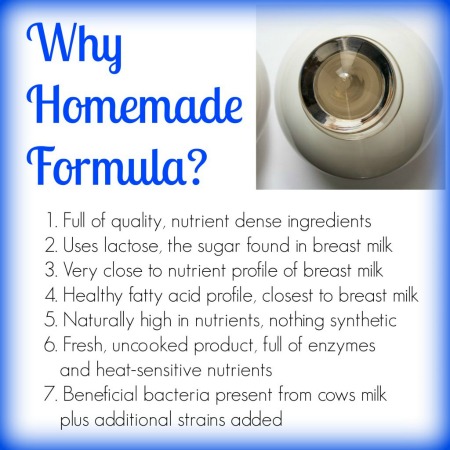
Where to Source Quality Milk
The most widely available grass-fed milk around the world is from cows. This is usually the most budget-friendly and easily sourced milk for this recipe for homemade formula.
If only goat milk is available in your area, this recipe for goat milk baby formula can be used instead. When using milk from ewes, please refer to the linked article for an adjusted recipe; one of the benefits of sheep milk is that it is higher in healthy fats than either goat or cow milk.
Camel milk formula is another option that is a particularly digestible form of dairy and growing in popularity around the world.
Alternatively, you can use low temp (vat) pasteurized, non-homogenized whole milk cultured with a piima or kefir starter. Then substitute the piima milk or kefir for the raw milk portion of the formula recipe. Cold-pressed raw milk also must be cultured before using it as it contains no probiotics.
Do NOT use ultrapasteurized (UHT) milk even if organic as it is too highly processed and extremely allergenic!
It is also best to avoid all types of powdered milk for this recipe. The factory process of making milk powder reduces nutrition considerably and denatures it, which makes it more likely baby will have an allergic reaction.
Dairy Allergy Option
If all types of dairy prove unsuitable for your baby, make this nondairy baby formula recipe instead. It uses a base of homemade bone broth as a substitute for milk. It is important not to utilize a plant-based or otherwise vegan baby formula recipe.
Avoid buying bone broth to make the dairy-free formula. Make it yourself! Manufacturers of commercial bone broth, even if authentic, may water down the end product. This is apparent if it does not gel when chilled in the refrigerator.
Many brands have toxic packaging issues as well. If you must buy it in a pinch, see my shopping guide page for vetted brands that are safe.
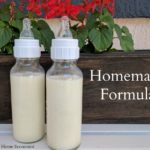
Homemade Baby Formula Recipe (for infants too)
A nourishing baby formula recipe you can make at home with safe, whole ingredients developed and tested by a PhD nutritionist to match breastmilk as closely as possible. Also suitable for infants.
Ingredients
- 2 cups raw cow milk OR organic whole milk yogurt
- 1 7/8 cups filtered water
- 1/4 cup liquid whey
- 4 Tbl lactose
- 1/4 tsp Bifidobacterium infantis powder
- 2-4 Tbl raw or pasteurized cream
- 1/2 tsp cod liver oil unflavored
- 1/4 tsp butter oil unflavored
- 1 tsp sunflower oil preferably organic
- 1 tsp extra virgin olive oil preferably organic
- 2 tsp virgin coconut oil preferably organic
- 2 tsp nutritional yeast
- 2 tsp gelatin
- 1/4 tsp acerola powder
Instructions
-
Fill a 2 cup Pyrex measuring cup with filtered water and remove 2 TBL (this will give you 1 7/8 cup water).
-
Pour about half the water into a pan and turn burner on medium.
-
Add the gelatin and lactose and let dissolve, stirring occasionally.
-
When gelatin and lactose are dissolved, remove pan from heat and add the rest of the water to cool.
-
Stir in the coconut oil and butter oil until melted.
-
Put remaining ingredients in a glass blender.
-
Add the water mixture and blend for about 3 seconds.
-
Place formula in glass baby bottles or a glass jar and refrigerate.
-
Before giving to baby, warm glass bottle in a pan of hot water or a bottle warmer. NEVER microwave baby bottles!
Recipe Video
Recipe Notes
If using raw cow milk from holstein cows, use 4 Tbl of extra cream (otherwise use 2 Tbl extra cream).
If choosing to make this homemade formula with camel milk, be sure to include 4 Tbl extra cream as camel milk is lower in cream than cow milk.
Do not use high oleic sunflower oil. Use only the brand recommended in the ingredients list which is cold pressed, organic, unrefined, and low oleic.
*Do NOT use powdered whey from the store as it is denatured. Avoid whey from making cheese as it will curdle the formula.
*Do not substitute pasteurized or powdered milk as these are heavily processed, denatured and allergenic foods.
*Do NOT use ultrapasteurized (UHT) cream. It is highly allergenic. Raw or pasteurized cream is acceptable.
*Do NOT use fish oil or krill oil instead of high vitamin cod liver oil as they do not contain any Vitamin D and very little to no Vitamin A.
Collagen powder may be substituted for the gelatin in a pinch (more on peptides in baby formula in this article).
If you are wondering where is the iron in homemade baby formula, this article provides an explanation.
If baby experiences constipation using this formula, try adding 1 tsp of molasses to each batch. This should help move things along.
How to Transition to DIY Formula
Once you’ve viewed the video, gathered the ingredients, and made your first batch, how do you feed it to your baby for the first time?
It is important not to switch all at once as this can cause gas, excessive spit-up, or an uncomfortable change in diaper habits such as constipation or overly loose stools.
Start by giving your baby three-quarters of the old formula blended with one-quarter of the homemade. Try this ratio for a day or two and see how your infant responds.
If no digestive upset or major change in diaper habits occurs, increase the amount to a 50-50 blend of old formula to homemade. Observe for another day or two as before.
If no major issues, increase once again to three-quarters homemade formula to one-quarter old formula. If baby does well on this blend for a third time, you are ready to fully transition to the homemade formula.
At any time during the transition, symptoms of intolerance emerge, back up to the previous successful blend ratio and stay there for a day or two before attempting to increase once again.
Homemade Formula FAQ
Weston Price Foundation
Feeding an Adopted Baby
Traveling Tips with Baby Formula Made at Home
Iron in Baby Formula
Collagen Peptides instead of Gelatin for Homemade Formula?


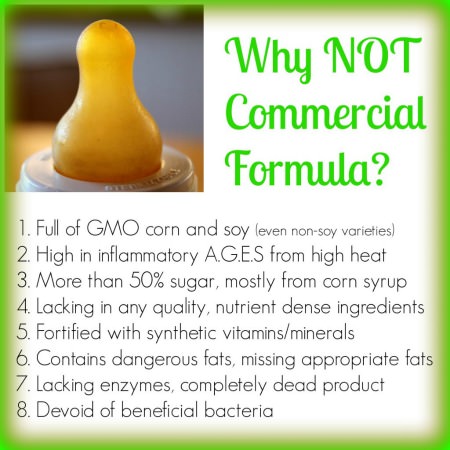
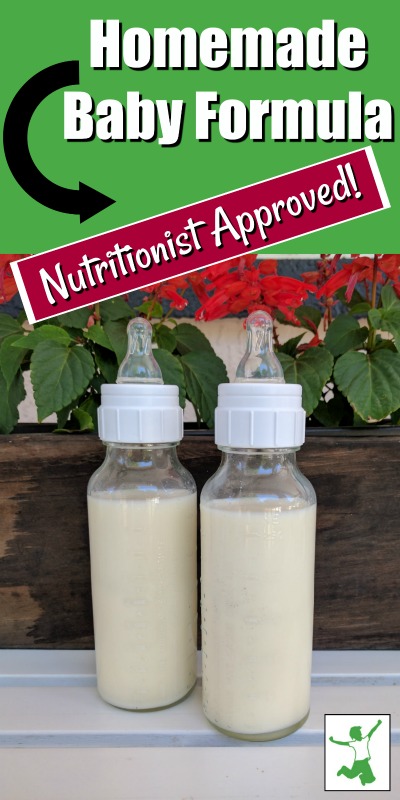






Hi Sarah,
Is the formula you produce in your video good for a newborn infant? Should we make any changes to the formula based on the age of the child? Our son is only 2-1/2 weeks old.
Thanks for helping !!
Derek
Hi Derek, this formula is fine for newborns. I used it myself with one of my children when he was only a few weeks old and I needed to get some dental work done and had to pump and discard breastmilk for a day or two until the novocaine got out of my system.
Hi Sarah,
Is the Bernard Jensen’s brand known to be gelatin from grass-fed cows? I can’t seem to find that info on the bottle. Our local store sells another brand of gelatin but doesn’t say anywhere if it is organic or grass-fed. Should I try to contact the company? Can beef stock be used as a substitute for gelatin?
Thanks,
Ranjani.
Is cow colostrum safe for infants?
Thanks for posting this video! I’ve been using the milk based formula for my baby for about 6 months, since he was 2 months old. A few things I have learned to do differently to help with some issues we had in the beginning are: I turn the milk to kefir (this helped to eliminate constipation); I dissolve all the dry ingredients in the water, except the probiotic (this has eliminated all spit up issues); and I add a touch more of the probiotic (which I believe also helped to eliminate the constipation). My baby is a very healthy baby, strong and happy. Before discovering this homemade formula recipe, I was feeding him commercial formula. He was constipated and grumpy on milk based commercial formula, and I was considering a hypoallergenic formula. Luckily I found Nourishing Traditions recipe, and with the help of many experienced homemade formula users, was able to make a few modifications which made it work beautifully. I strongly recommend it to all mothers who cannot breastfeed, as it has made such a difference in our lives. 🙂
Fantastic testimonial, Michelle. Thank you for taking the time to share your story so as to empower other Mothers considering the homemade formula for their babies!
Hi Michelle & Sarah, I am wondering if there is an online group/forum of mom’s making homemade formula? My son is a little puzzle. I want to keep with the homemade formula that I started last week, but he’s started puking today. 🙁
there is a yahoo group you can join. search for weston a price yahoo group healthy baby and you should find it.
hi michelle, thanks for your comment, it really helps! just wondering if you ever had to skip any ingredient for any reason? and how did that work out?
They no longer carry “salted cod” liver oil, what is the replacement oil?
Plain or antioxidant free is fine.
Sarah, You mentioned in the video to use Frontier brand Nutritional Yeast Flakes specifically because they are dried at low temperature. I called Frontier & asked about this. All they could say is that it is not cooked but heat may be used in the drying process. I inferred & discussed with the rep that the heat must be lower than 118 F. The origin is propriety information, but it is made in the USA. When I talked to Now Foods, they could not tell me the temperature theirs is dried at, however, whatever it is, the nutrients are retained. Their source is Lesaffre & Red Yeast. I do not see NYF on their website, unless they have another name for it. I have used both brands & cannot tell any difference. Do you know of any? Also, is it necessary to buy certified organic NYF? Thanks for your help!
Hi Gennifer, wet heat is hotter than dry heat in its ability to destroy enzymes. 118F is the max temp for liquids to maintain enzymes but it is 150F for dry heat as in dehydrating. So, if the Frontier yeast is 150F or lower which is my understanding that it is from the WAPF, then that is the one to choose. I do not know about the NOW brand. The Frontier brand is organic I believe. At least it was the last time I bought some.
Hi Sarah, question… my husband is totally against cows milk for humans. Why is cows milk the preferred choice? And also, I have heard that humans cannot use animal enzymes to help them incorporate vitamins and minerals. If this is so, why is pasteurization so bad, and incorporating enzymes back into milk doesn’t make sense? I know it kills a portion of the heat sensitive vitamins (A, C?), but others are not as sensitive to heat, and the minerals are not affected by heat. Please enlighten. Thanks for all you work!
Chris
Chris, not sure where to even begin with your questions. First of all, many traditional societies relies on dairy from cows as a primary food. The Swiss is one that comes to mind. The enzymes in raw milk are not “animal” enzymes .. they are simply enzymes that help digest whatever nutrient is in the food. For example, lactase in raw milk is the enzyme that digests lactose, milk sugar. Lactase is present in human breastmilk as well as raw cow’s milk. It is destroyed by pasteurization which is why many folks are “lactose intolerant” and cannot digest processed store milk. On raw milk, however, they are fine as the lactase is present to digest the lactose and no digestive problems manifest. Hope that helps!
Hi Sarah,
I read in Nourishing Traditions that the presence of the gelatin and lactic acid may help with constipation and vomiting. My son is horribly constipated. Do you think it may help if I increase the amounts of these ingredients? Also, am I right that the lactic acid is found in the whey?
Hi Traci, yes the lactic acid is in the liquid whey. I would not change the ingredients but would perhaps seek a holistic physician for assistance in this area. Another option is to try the hypoallergenic formula instead (I have a video on this as well).
Hi Sarah
I am wondering if you would suggest using an enzyme with this formula to help the baby break down the dairy proteins. My son seems to do the best on the cows milk formula. We tried goats milk too. He got constipated from both but not as bad with the cows milk. An Herbalist I work with has suggested I use some Amylase along with increasing the probiotic. What do you think?
I really don’t know about the amylase but slightly increasing the probiotic should be ok.
My 4 month old has been on this formula since 6 weeks of age, he is doing great with and growing like a weed. Just last week though, he started getting constipated and I can’t figure out why. Is increasing the probiotic the first step I should take to try to resolve the issue?
Thanks for showing how to make the Weston A. Price recipe! We prefer to use raw goat’s milk for ours, but are curious as to whether we should use cow’s milk cream or skim off the top of the goat’s milk we use for our own consumption. We are concerned about cow’s milk allergies in our family. We are using this formula since my partner had a breast reduction, and has low milk supply (we supplement via home made SNS), and I am so far unable to induce lactation.
Speaking of partners, I sure would appreciate if your language wasn’t so heteronormative. It’s not that hard to say “partner” instead of “dad” seeing as how that word is practically all-inclusive unless mom is a single parent.